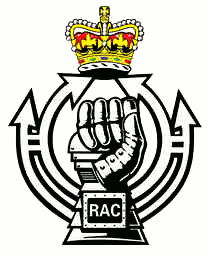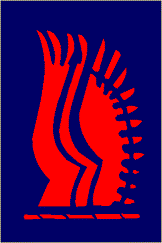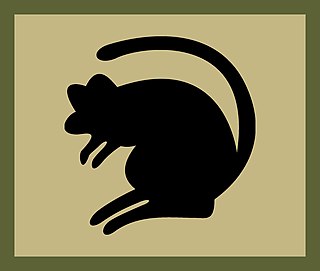Related Research Articles

The Royal Armoured Corps is the armoured arm of the British Army, that together with the Household Cavalry provides its armour capability, with vehicles such as the Challenger 2 and the Warrior tracked armoured vehicle. It includes most of the Army's armoured regiments, both the Royal Tank Regiment and those converted from old horse cavalry regiments. Today it comprises twelve regiments, eight regular and four Army Reserve. Although the Household Cavalry Regiment provide an armoured regiment, they are not part of the RAC.
The Infantry of the British Army comprises 49 infantry battalions, from 19 regiments. Of these, 33 battalions are part of the Regular army and the remaining 16 a part of the Army Reserve. The British Army's Infantry takes on a variety of roles, including armoured, mechanised, air assault and light.

160th (Welsh) Brigade or Brigâd 160 (Cymru), is a regional brigade of the British Army that has been in existence since 1908, and saw service during both the First and the Second World Wars, as part of the 53rd (Welsh) Infantry Division. It is a regional command responsible for all of Wales. The Brigade is also regionally aligned with the Eastern European and Central Asian regions as part of defence engagement.
The 2003 Defence White Paper, titled Delivering Security in a Changing World, set out the future structure of the British military, and was preceded by the 1998 Strategic Defence Review (SDR) and the 2002 SDR New Chapter, which responded to the immediate challenges to security in the aftermath of the September 11 attacks in 2001. Published under the then Secretary of State for Defence, Geoff Hoon, the report effectively introduced a series of cutbacks to core equipment and manpower and the scaling back of a series of future capital procurement projects. This was justified due to the implementation of a policy termed Network Enabled Capability. The review also outlined a major restructuring and consolidation of British Army Infantry regiments.

The Royal Australian Armoured Corps (RAAC) is an administrative corps of the Australian Army. It provides the Australian Defence Force's Armour capability, which performs the function of mounted combat. Armour combines firepower, mobility, protection and networked situational awareness to generate shock action and overmatch in close combat. Armour is an essential element of the combined arms approach that is employed by the Australian Army.
The Rifles is an infantry regiment of the British Army. Formed in 2007, it consists of four Regular battalions and three Reserve battalions. Each Regular battalion of The Rifles was formerly an individual battalion of one of the two large regiments of the Light Division. Since formation, the regiment has been involved in combat operations in the later stages of the Iraq War and in the War in Afghanistan.

16 Air Assault Brigade Combat Team, known simply as 16 Air Assault Brigade from 1999 – 2021, is a formation of the British Army predominantly based in Colchester, Essex. It makes up the Air Assault Task Force, a battlegroup held at high readiness, and is the only brigade in the British Army focused on operating via parachute, helicopter and air-landing.

The 7th Light Mechanised Brigade Combat Team is a formation in the British Army with a direct lineage to 7th Armoured Brigade and a history that stretches back to the Napoleonic Wars. It saw active service in the Crimean War, the Second Boer War and both the First and the Second World Wars. In 2014, the 7th Armoured Brigade was re-designated as 7th Infantry Brigade, thereby ensuring that the famed "Desert Rats" continue in the British Army's Order of battle.

The 1st Armoured Infantry Brigade was an infantry brigade of the British Army with a long history including service during both the First and the Second World Wars. It was based at Tidworth Camp. Previously, it has been designated 1st (Guards) Brigade, 1st Infantry Brigade, 1st Mechanised Brigade, and under the initial Army 2020 reforms assumed the title of 1st Armoured Infantry Brigade. Under the Future Soldier programme, the brigade merged with the 1st Artillery Brigade to form the 1st Deep Recce Strike Brigade Combat Team.

The 24th Infantry Brigade was an infantry brigade of the British Army from the First World War. It was reraised during the Second World War, as the 24th Infantry Brigade (Guards). During various designations, the brigade was active throughout the Cold War and existed until 1999, when it was merged with the 5 Airborne Brigade to become 16 Air Assault Brigade.

The 38th (Irish) Brigade, is a brigade formation of the British Army that served in the Second World War. It was composed of North Irish line infantry regiments and served with distinction in the Tunisian and Italian Campaigns. Following the end of the war, the brigade was disbanded, but was reformed in sixty years later in 2007 and remains the regional formation for Northern Ireland.

4th Light Brigade Combat Team, previously known as 4th Infantry Brigade and Headquarters North East, and before that as 4th Mechanized Brigade and before that 4th Armoured Brigade is a brigade formation of the British Army, currently based in Catterick, North Yorkshire as part of 1st Division. The brigade, now known as the 'Black Rats', was formed in 1939 and fought in the Second World War in the Western Desert Campaign in North Africa. The Black Rats were subsequently involved in the invasion of Sicily and fighting in Italy before taking part in the Battle of Normandy and the advance through Belgium, Holland and into Germany.
The British Commonwealth Far East Strategic Reserve was a joint military force of the British, Australian, and New Zealand armed forces. Created in the 1950s and based in Malaya, the FESR was conceived as a forward defence point for Australia and New Zealand, while protecting Commonwealth interests in the Southeast Asian region from both internal and external communist threats. The FESR was made up of an infantry brigade and an aircraft carrier group, supported by squadrons of aircraft.

The 11th Security Force Assistance Brigade is a brigade of the British Army which is intended to train and assist foreign forces. In 2021, under the Future Army changes, the brigade was redesignated, formerly being the 11th Infantry Brigade & HQ South East. Prior to the Army 2020 changes in 2013, the brigade was temporarily activated for deployment to Afghanistan. Originally formed in the Second Boer War, the brigade was engaged during both World Wars.
Armoured regiments are units provided by the Royal Armoured Corps of the British Army.
Army 2020 Refine was the name given to the restructuring of the British Army in the mid-to-late 2010s, in light of the Strategic Defence and Security Review 2015. As its name suggests, it was a "refinement" of Army 2020, an early 2010s reorganisation of the Army to be completed by 2020, originally conducted in light of the Strategic Defence and Security Review 2010.
Army 2020 was the name given to the restructuring of the British Army in the early and mid-2010s, in light of the Strategic Defence and Security Review 2010. The plan, as its name suggested, was intended to be completed by 2020, though most of its reorganisations were completed by the middle of the decade. It was succeeded by Army 2020 Refine, a series of new changes and refinements of Army 2020's restructuring, conducted in light of the Strategic Defence and Security Review 2015.

The page contains the current structure of the British Army. The British Army is currently being reorganised to the Future Soldier structure.
Future Soldier is a reform of the British Army resulting from the Integrated Review of Security, Defence, Development and Foreign Policy published in March 2021. The aim of the reform is to create a more lethal, agile and expeditionary force, able to fight and win wars and to operate in the grey-zone between peace and war. Future Soldier was published on 25 November 2021 and deals with the organizational changes of the British Army, with changes to personnel and equipment were set out in the Defence in a Competitive Age paper published on 22 March 2021.

The Armed forces in Wales are the military bases and organisation in Wales or associated with Wales. This includes servicemen and women from Wales and Welsh regiments and brigades of the British Armed Forces.
References
- 1 2 3 4 5 6 7 Defence in a Competitive Age (PDF). Ministry of Defence. March 2021. ISBN 978-1-5286-2462-6. Archived (PDF) from the original on 2021-03-22. Retrieved 22 March 2021.
- ↑ "Warship to be based permanently in Gibraltar". UK Defence Journal. 22 March 2021. Retrieved 22 March 2021.
- ↑ "First Sea Lord Sea Power Conference Speech 2021". Royal Navy. 19 May 2021. Retrieved 21 May 2021.
- ↑ "Royal Navy to get new surveillance ship". UK Defence Journal. 21 March 2021. Retrieved 22 March 2021.
- 1 2 3 4 5 6 7 8 "Integrated Review: Defence Command Paper, Volume 691: debated on Monday 22 March 2021" . Retrieved 2021-03-23.
- ↑ "UK announces new Type 83 Destroyer". UK Defence Journal. 22 March 2021. Retrieved 22 March 2021.
- 1 2 3 "Integrated Review: Defence Command Paper, Volume 691: debated on Monday 22 March 2021" . Retrieved 2021-03-23.
- ↑ "Future Soldier: What is the British Army being promised as part of modernisation plans?". BFBS . 26 November 2021. Retrieved 25 November 2021.
- 1 2 "Future Soldier". www.army.mod.uk. Retrieved 2021-05-15.
- ↑ Chuter, Andrew (2021-03-23). "Who are the winners and losers in Britain's new defense review?". Defense News. Retrieved 2021-03-24.
- 1 2 3 4 5 6 7 8 9 Defence in a Competitive Age (PDF). Ministry of Defence. March 2021. ISBN 978-1-5286-2462-6. Archived (PDF) from the original on 2021-03-22. Retrieved 22 March 2021.
- ↑ "Written statements - Written questions, answers and statements - UK Parliament". questions-statements.parliament.uk. Retrieved 2021-02-20.
- ↑ White Paper, p. 58.
- ↑ "Integrated Review: Defence Command Paper, Volume 691: debated on Monday 22 March 2021" . Retrieved 2021-03-23.
- ↑ "New Army Ranger Regiment: What We Know So Far". Forces Net. 24 March 2021. Archived from the original on 2021-03-24. Retrieved 2021-03-24.
- 1 2 "First glimpse of 'Future Soldier'". Soldier Magazine. 1 August 2021. p. 14.
- ↑ "UK Defence Command Paper: MoD circumspect on future F-35 numbers". Janes. 22 March 2021.
- ↑ Allison, George (2021-03-23). "UK looking at '60 and then maybe up to 80′ F-35B jets" . Retrieved 2021-03-24.